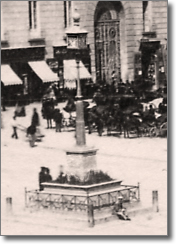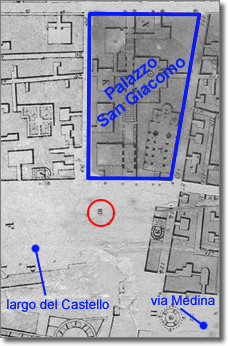
- the city-clock, detail from a stereoscopic photo, 1858-59
During the XIX century the research of possible applications of electrical energy ranged over the field of instruments for the timing allowing the production of motor synchronous electric clocks characterized by the simplicity of the works and the optimal precision. The design of road clocks began, and the first models started to appear in the international industrial exhibitions.
The innovation provoked the interest of the king Ferdinando II di Borbone-Due Sicilie who, in 1853 agreed to buy an exemplar "ad uso di piazza pubblica" (for the public use) that had to be placed "in uno de' larghi di questa Capitale" (in a square of Naples). The commision was entrusted to Giovanni de Normann, "meccanico della Reale telegrafia elettrica" (mechanic of the Royal electical telegraphy), which bought the clock in the distant England.
The equipment was carried by train from London to Liverpool where, embarked on a steamer, it began the travel to Naples and arrived, damaged, in the month of October 1853. The price, because of the purchase, the transport and the repairing, reached 1000 ducats, figure that paid the civic Administration.
At that point they needed to decide where to put the clock. The king wanted to put it in Largo del Castello (the current piazza del Municipio), as a matter of fact the municipal building Council had the task to search a placing in the area of the huge square.
